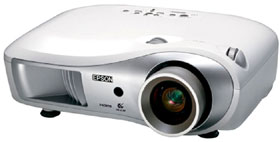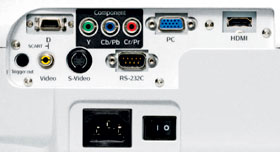|
 Go Back Go Back
 Print Page Print Page
Epson Powerlite Home Cinema 1080 Home Theater Video Projector Review
LCD Home Theater Projector Review & Buying Guide
By Anthony Marsh
Manufacturer: www.epson.com
Verdict: HIGHLY RECOMMENDED
For those looking to jump-start their home theater experience and give it that much-needed jolt of high-def adrenaline, comprised of images that feature bright, vivid colors, and rich, dark blacks, the Epson 1080 is a sure-fire winner and must-have projector.
AT A GLANCE
Overview / First Impressions / Performance / Final Thoughts / Detailed Specifications
PROS |
CONS |
- Native 1080P (1920 x 1080) resolution featuring a 3LCD projection system
- Superb out-of-box image quality with a terrific host of available picture presets
- AbsoluteBlack™ technology ensure deep and rich blacks
- 2.1:1 zoom lens makes setting up in any room a snap
- Vertical and horizontal lens shift get your image just right, and eliminates the need to keystone
- Lightweight and modest dimensions make this unit very portable
- Looks great, with a modern design that will enhance any room
- Highly functional and backlit remote
|
Only one HDMI input, but I’m just nitpicking really, and at least the HDMI input it does have is a 1.3 |
OVERVIEW – Epson LCD Projector
Epson 1080 Highlights:
- Native 1080P (1920 x 1080) resolution
- Up to 1200 ANSI lumens (Dynamic Mode)
- Up to 12,000:1 advertised contrast ratio (Dynamic mode)
- C²Fine™ 3LCD (3-chip optical engine) technology
- Includes HDMI and Component connectivity inputs
- AbsoluteBlack™ technology and Auto Iris Control for the deep, rich blacks
- Horizontal and vertical lens shift
- Backlit remote with one-touch gamma, picture preset, and color control
- Lamp life of up to 3000 hours
- Two-year quick exchange warranty (includes priority, toll-free technical support), plus 90-day lamp warranty
MSRP: $2,499.99
For those looking to make the proverbial splash into the home theater video projector market, Epson’s flagship line of Powerlite Home Cinema LCD projectors – specifically the Epson 1080 – could be just what you’re looking for to create that astounding ripple that will make people stand up and take notice of.
FIRST IMPRESSIONS – Epson LCD Projector
Style & Appearance
As discussed in prior reviews, the Epson 1080 home theater projector shares the exact same color case (dubbed “pearlescent” by Epson) and modern design style as the 1080 UB and the 720. This is a good thing, because from a design perspective, you’d be hard-pressed to find video projectors that look as good as these ones do. But looks aren’t everything – and thankfully, the 1080 has plenty of substance to match its contagious charm.
Getting Connected
From a connection numbers standpoint, the 1080 essentially mirrors all the inputs featured on the Epson 720, with one of each of the following: HDMI (1.3) Component, S-Video, Composite, and Analog RGB (PC). Similar to the 720, an additional HDMI input would’ve been nice for added input flexibility, but alas, you’ll likely be running through a home theater receiver/switcher, so it’s really not an issue. As it stands, it’s really just a minor quibble when you take into account the great out-of-box picture and ease of set-up that this projector has to offer.
Remote Control
| The remote control for this unit is identical to the one for the 1080 UB and the 720. What the designers saved themselves in design time, they more than made up for in a practical features design-sense. Allow me to explain: with many remotes you often get a slew of useless options which serve no purpose other than to fill vacant space on the remote (PIP, anyone?). With the 1080 remote, you get a soothing-on-the-eyes-yet-ultra-functional backlit remote control, with a host of button options that give you one-touch access to useful features such as Color Temperature, Gamma, Color Mode, and a Memory button to store and load any changes you’ve made along the way. Further, the remote’s buttons are nicely laid-out and ergonomically accessible. |
|
PERFORMANCE – Epson LCD Projector
Set-Up
If you’ve never in your life set up a projector before, have no fear and breathe easy. The 1080 features vertical (96%) and horizontal (47%) lens shift. This feature all but eliminates the need for keystoning: simply adjust left-right, up-down, and in a matter of minutes, you’ll be good to go. And with a 2.1:1 zoom lens, this unit affords you an extremely short throw distance. I set mine up in a room with limited space and was able to project an image just over 100 inches, at less than 10 feet back. Conversely, you can go as far back as 21 feet and project the very same image size. So whether you have lots of room or limited space, the Epson 1080 projector works around your particular circumstances. That’s extremely crafty engineering on the part of Epson. If only everything in life was this accommodating. But I digress…
Out-Of-Box Picture
Standard operating procedure when testing a video projector out-of-box – without the benefit of any image adjustments – says that your picture usually never inspires much in the way of audience applause and appreciation. In this regard, the 1080 was a pleasant surprise. I tested the unit using BBC’s Planet Earth with a PS3 for HD playback, connected via HDMI and component, alternating between 720P, 1080I, and 1080P. With respect to the different connections and resolutions, I found no obvious and discernable differences in image quality. Had I chose to watch less than two feet away from my screen, perhaps the 1080P high-resolution benefits would’ve factored into the equation. But as it was, everything was uniform across the board. Color gamut showed great range, colors were crisp and sharp, details in the blacks were good, and the whites, in particular, had some real snap to them. Again, I haven’t touched a single thing and I’m already impressed.
Now I decide to do a little image tweaking by eye. I adjust as follows, and leave a few other things as they are:
| Color Mode |
Theater Black 1 |
| Brightness |
-1 |
| Contrast |
+1 |
| Color Saturation |
+5 |
| Tint |
+5 |
| Color Temperature |
6500K |
| Brightness Control |
High |
| Epson Super White |
Off (default) |
At this point, the unit’s color gradation is impressive, and color banding is basically non-existent. Typically, issues of color banding and sub-par color gradation are usually more apparent in scenes where things like the sky or a sunset aren’t rendered as one whole, with all the subtle shades of one color making up the image. Rather, you are able to see “banding,” or where different shades of the same color begin and end; in essence, an
image that is not smooth. This is what you don’t want. At any rate, image quality is more defined, and the subtle details in the darkest and brightest parts of the picture are rendered with greater precision. With just the most basic of tweaks, the Epson 1080 projects a fantastic image. Very few projectors offer such plug and play functionality that doesn’t sacrifice image quality, but the 1080, is indeed, one of those rare breeds. The next bit of testing would involve calibrating this home theater video projector to see what else I could possibly squeeze out of it.
Calibration
The Epson 1080 is one of the more intuitive and straight-forward projectors I’ve ever had the pleasure of calibrating. Post-calibration image settings were so close to the ones done by naked eye, I could hardly believe it. This only further reinforces what an absolute beast of a performer this unit is out of the box. While the unit favored a red and blue color shift in the sub-30 IRE range, once Absolute Co lour Temperature was adjusted from the 7000K factory setting to 6500K, blue and red became far more obedient. In the high-brightness 70 IRE range and above, while there was a red and blue co lour shift as well, this one was less pronounced. This is nothing unusual, and many of the made-to-order image options available in the projector’s main menu do a great job of balancing out the vast co lour gamut perfectly across the board.
This Epson 1080 is clearly making full use of native, 1080P HD horsepower, driven by a souped-up engine featuring 10-bit color processing and C²Fine™ 3LCD technology. In all of this calibration talk, I’d like to reiterate just what a treat Epson’s Advanced Image display menu is. It offers you complete and total control over the RGB settings in the gain and offset categories. With some skillful adjusting here, I was able to get the unit bang on to the 6500K (actually 6487) mark which is the ideal setting for giving you the most accurate and realistic co lour reproduction. While the understated nuances of the very dark or very bright scenes, in particular, had more detail to offer post-calibration, this is by no means something you have to do to maximize your viewing enjoyment. As is, with just some simple image adjustments available in the Image menu, you’ll be more than satisfied with the results
FINAL THOUGHTS – Epson LCD Projector
When it comes to home theater video projectors, the playing field is literally littered with an infinite, mind-numbing, head-scratching array of players. Generally, they fit into one of two categories: the pretenders and the contenders. I’m sure you’ll have no problem in guessing where I’d classify the Epson 1080. Ease of set-up, great out-of-box performance, a powerful collection of image presets, and a great price-point all combine for a memorable home theater experience that’s quite easy to recommend in the 1080P projector class.
DETAILED SPECIFICATIONS – Epson Powerlite Home Cinema 1080
| Projection System |
Epson C²Fine™ 3LCD technology |
| Projection Method |
Front / rear / ceiling mount |
| LCD |
Three 0.74" wide, poly-silicon TFT active matrix |
| Projection Lens |
F-number: 2.0 – 3.17
Lens Shift Range
Vertical ±96%
Horizontal ± 47% |
| Lamp |
170 W UHE E-TORL™ lamp
Lamp Life
Up to 3000 hours |
| Screen Size (Projected Distance) - 16:9 Image |
100" (wide: 9.8' – tele: 20.9') |
| Brightness |
Up to 1200 lumens (Dynamic Mode) |
| Contrast Ratio |
Up to 12,000:1 (Dynamic Mode) |
| Color Reproduction |
Built-in Y/C separation and I/P conversion
Powered by Pixelworks™ |
| Adjustment Function |
Manual zoom
Manual focus
Zoom Ratio: 1 – 2.1 |
| Video I/O |
Video Compatibility
NTSC, NTSC4.43, PAL, M-PAL, N-PAL, PAL60, SECAM, 480i, 480p, 720p, 1080i, 1080p
Video Input Signal
NTSC, NTSC4.43, PAL, M-PAL, N-PAL, PAL60, SECAM, 480i, 480p, 720p, 1080i, 1080p
Terminal Inputs
HDMI
3 RCA (Component)
1 RCA (Composite)
1 Mini Din (S-video)
1 Mini D-Sub 9 pin (RS-232c)
1 Mini D-Sub 15 pin (Analog RGB)
D4/SCART |
| RGB |
Video Compatibility
HDMI, HDTV, Component video, S-video, Composite video, NTSC/PAL/SECAM, Analog RGB, D4/SCART |
| Power Consumption |
120V
Lamp On: 245W (lamp high), 200W (lamp low)
Standby: 4W |
| Dimensions |
16" x 12.2" x 4.9" (406 x 309 x 124 mm) |
| Weight |
12.3 lbs (5.6 kgs.) |
Verdict recommendations are ranked from best to worst as follows:
Highly Recommended
Recommended
Moderate Recommendation
Take A Pass
Avoid Like The Plague
|
Video Projector Reviews
JVC DLA-X30 Review
Boxlight Pro7501dp
Panasonic PT-AE4000U
Mitsubishi HC4000 Review
JVC DLA-HD250 Review
HC3800 vs 8100
JVC DLA-HD550
Boxlight Projectowrite2
Epson 8100 Review
Epson 8500UB
Boxlight MP65E
More Projector Reviews
|



